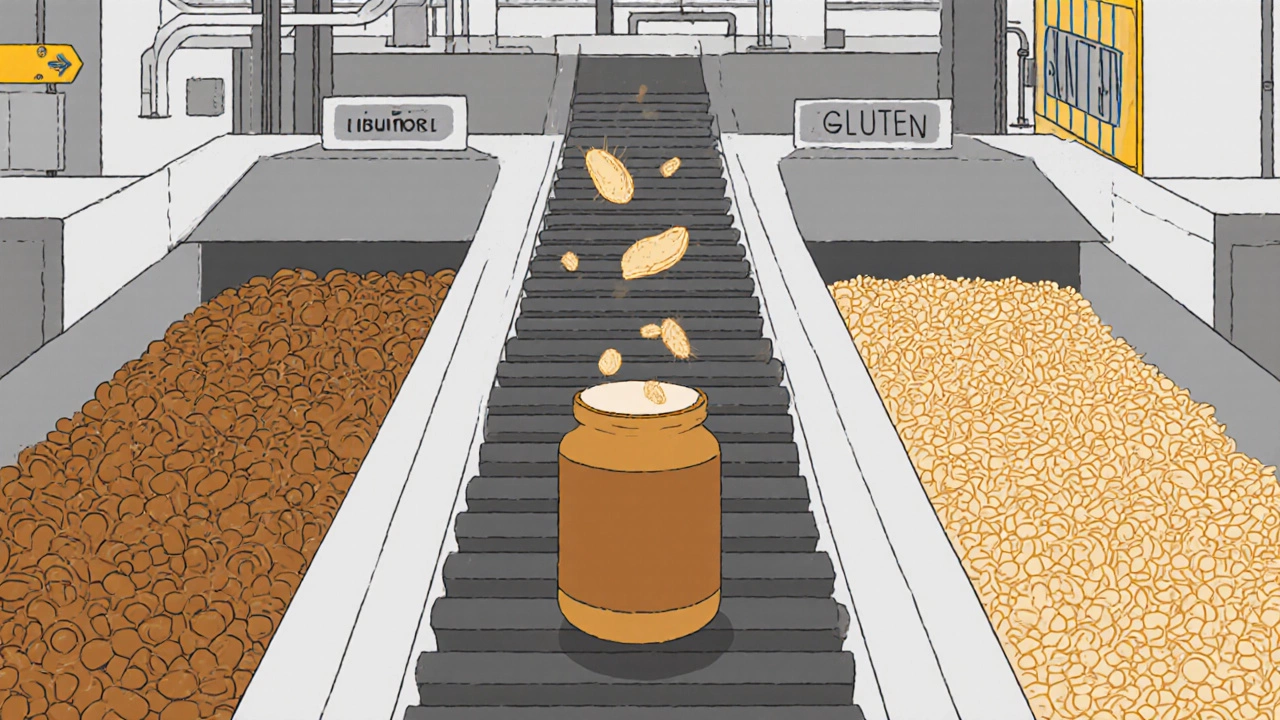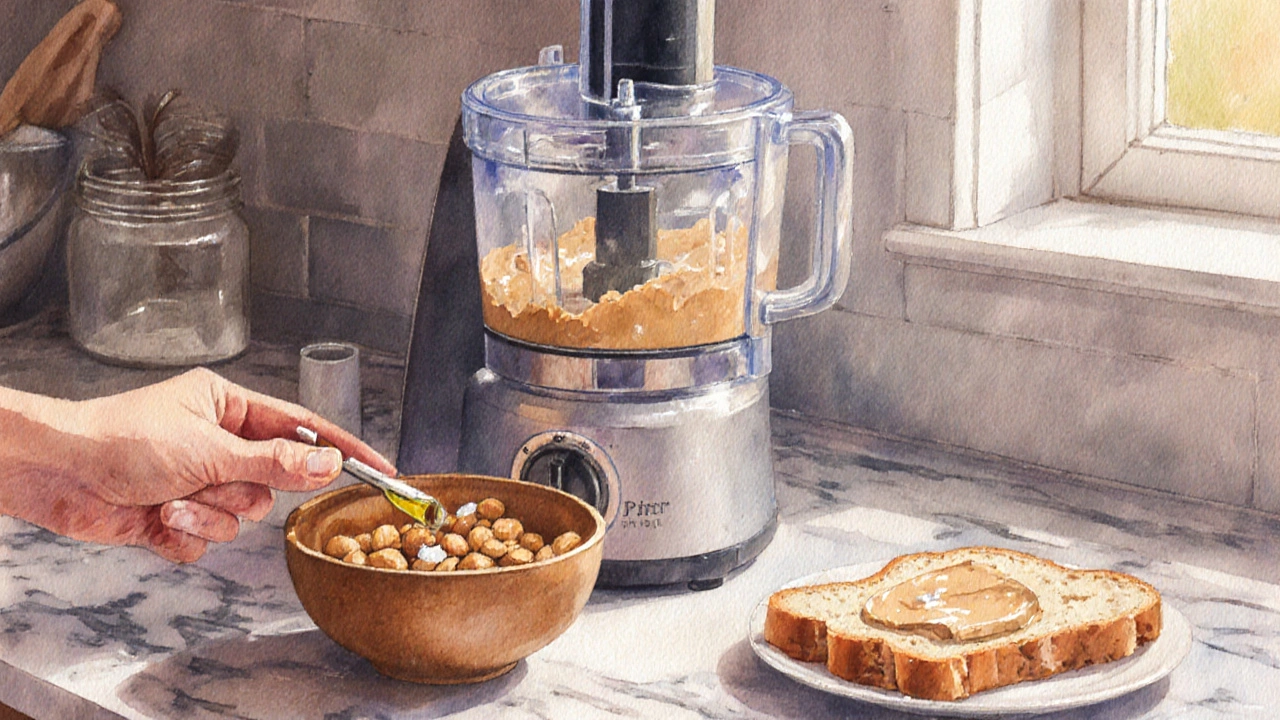Key Takeaways
- Pure peanut butter is naturally gluten‑free.
- Gluten can appear via added ingredients (like honey‑roasted flavorings) or cross‑contamination in shared facilities.
- Look for a clear "gluten‑free" label or certification from FSANZ.
- Trusted brands such as Skippy Natural, Jif Natural, and Whole Foods 365 are generally safe.
- Making your own spread guarantees no hidden gluten.
When you spread Peanut butter is a smooth or crunchy paste made from roasted peanuts, often seasoned with salt, sugar, or oil, the first question for many with celiac disease or gluten sensitivity is whether it contains gluten. The short answer: plain, pure peanut butter is naturally gluten‑free, but the reality gets murkier once flavors, additives, or shared production lines enter the picture. This guide breaks down where gluten can sneak in, how to read labels, which brands are safe, and what to do if you want total control.
What is Gluten?
Gluten is a group of proteins found primarily in wheat, barley, and rye. It gives dough its stretchy quality and helps baked goods hold together. For most people gluten is harmless, but for those with celiac disease, gluten triggers an immune response that damages the small intestine.
Celiac disease is an autoimmune disorder where ingesting gluten leads to intestinal inflammation and nutrient malabsorption. Symptoms range from digestive upset to fatigue, and the only treatment is a strict gluten‑free diet.
How Can Gluten End Up in Peanut Butter?
There are three main pathways:
- Added ingredients. Some flavored or “honey‑roasted” varieties include wheat‑based malt, soy sauce, or barley‑derived maltodextrin. These are direct sources of gluten.
- Cross‑contamination. If a plant processes peanuts alongside wheat‑based products, tiny gluten particles can transfer via equipment, air, or conveyor belts.
- Shared facilities. Even when the recipe is clean, the same factory may handle both gluten‑containing and gluten‑free products, raising the risk of accidental inclusion.
Regulators like Food Standards Australia New Zealand (FSANZ) set a threshold of less than 20ppm (parts per million) gluten for a product to be marketed as gluten‑free. Most major brands aim to stay under this limit, but they still label the risk when it’s possible.

Reading Labels Like a Pro
Here’s what to scan on the jar:
- Ingredient list. Look for wheat, barley, rye, malt, maltodextrin, or hydrolyzed wheat protein.
- Gluten‑free certification. In Australia, the “Gluten‑Free” logo from Coeliac Australia or a “Certified Gluten‑Free” claim means the product meets the <10ppm threshold.
- Allergen statements. Phrases such as "may contain traces of wheat" or "processed in a facility that also handles wheat" are red flags.
- Processing claims. Statements like "made in a dedicated gluten‑free facility" give extra confidence.
If the label is vague, call the manufacturer’s customer service. Most brands have a dedicated line for gluten‑related inquiries.
Trusted Gluten‑Free Peanut Butter Brands (2025)
| Brand | Gluten Status | Certification | Notes |
|---|---|---|---|
| Skippy Natural | Gluten‑free | Coeliac Australia Certified | No added sweeteners, processed in a dedicated line. |
| Jif Natural | Gluten‑free | Coeliac Australia Certified | Contains salt and palm oil, no wheat‑derived ingredients. |
| Whole Foods 365 Creamy | Gluten‑free | Coeliac Australia Certified | Organic peanuts, low‑salt option. |
| Naked Peanut Butter (Unsweetened) | Gluten‑free | None, but tested under 5ppm | No added sugars or oils; makes a thick spread. |
| Jif Honey‑Roasted | Contains gluten | None | Uses wheat‑based malt flavoring. |
| Skippy Creamy (Original) | May contain gluten | None | Manufactured in a shared facility; check allergen disclaimer. |
Make Your Own Gluten‑Free Peanut Butter
When you blend peanuts at home, you control every ingredient. Here’s a quick recipe:
- Toast 2cups of raw peanuts at 350°F (175°C) for 8‑10minutes until golden.
- Cool, then transfer to a food processor. Add ½teaspoon salt and 1‑2tablespoons neutral‑taste oil (e.g., grapeseed).
- Process on high for 5‑7minutes, scraping the sides occasionally, until smooth.
- For a crunchy version, set aside ½cup of the peanuts, chop coarsely, and stir back in after the blend is creamy.
This method eliminates any hidden additives and guarantees a gluten‑free product.

Common Myths & Pitfalls
- Myth: All peanut butter is gluten‑free because peanuts don’t contain gluten.
Reality: The base is gluten‑free, but flavorings and processing can introduce gluten. - Myth: “No wheat listed” means it’s safe.
Reality: Gluten can hide in maltodextrin derived from wheat; double‑check the label. - Myth: Small amounts of gluten are harmless.
Reality: For anyone with celiac disease, even a single grain can trigger damage.
Quick Troubleshooting Guide
- I’m experiencing symptoms after eating peanut butter. Check the ingredient list for hidden wheat‑derived additives. Switch to a certified gluten‑free brand or homemade version.
- The label says “processed in a facility that also handles wheat.” If you’re highly sensitive, avoid the product. Look for “dedicated gluten‑free facility” instead.
- Can I trust the “gluten‑free” logo? In Australia, the logo means <10ppm gluten, which is safe for celiac patients.
Frequently Asked Questions
Does natural peanut butter contain gluten?
Natural varieties that list only peanuts, salt, and oil are gluten‑free. Always verify the label for hidden wheat‑derived additives.
What gluten‑containing ingredients should I watch for?
Common culprits are malt, maltodextrin, hydrolyzed wheat protein, barley‑derived sweeteners, and wheat‑based flavorings. They may appear in honey‑roasted or chocolate‑swirl blends.
Is cross‑contamination a real risk?
Yes. If the same line processes wheat products, tiny gluten particles can migrate. Look for statements like “produced in a dedicated gluten‑free facility” to minimise risk.
Can I eat peanut butter on a strict gluten‑free diet?
Yes, as long as you choose a plain, certified gluten‑free brand or make it yourself. Avoid flavored spreads unless they carry a clear gluten‑free certification.
What should I do if I accidentally consume gluten in peanut butter?
Contact your healthcare provider, especially if you have celiac disease. Most symptoms resolve quickly, but monitoring is essential.
Bottom line: pure peanut butter is a safe, protein‑packed snack for anyone on a gluten‑free regimen. The key is staying vigilant about added flavors, reading every label, and opting for certified brands or a homemade batch when uncertainty looms.